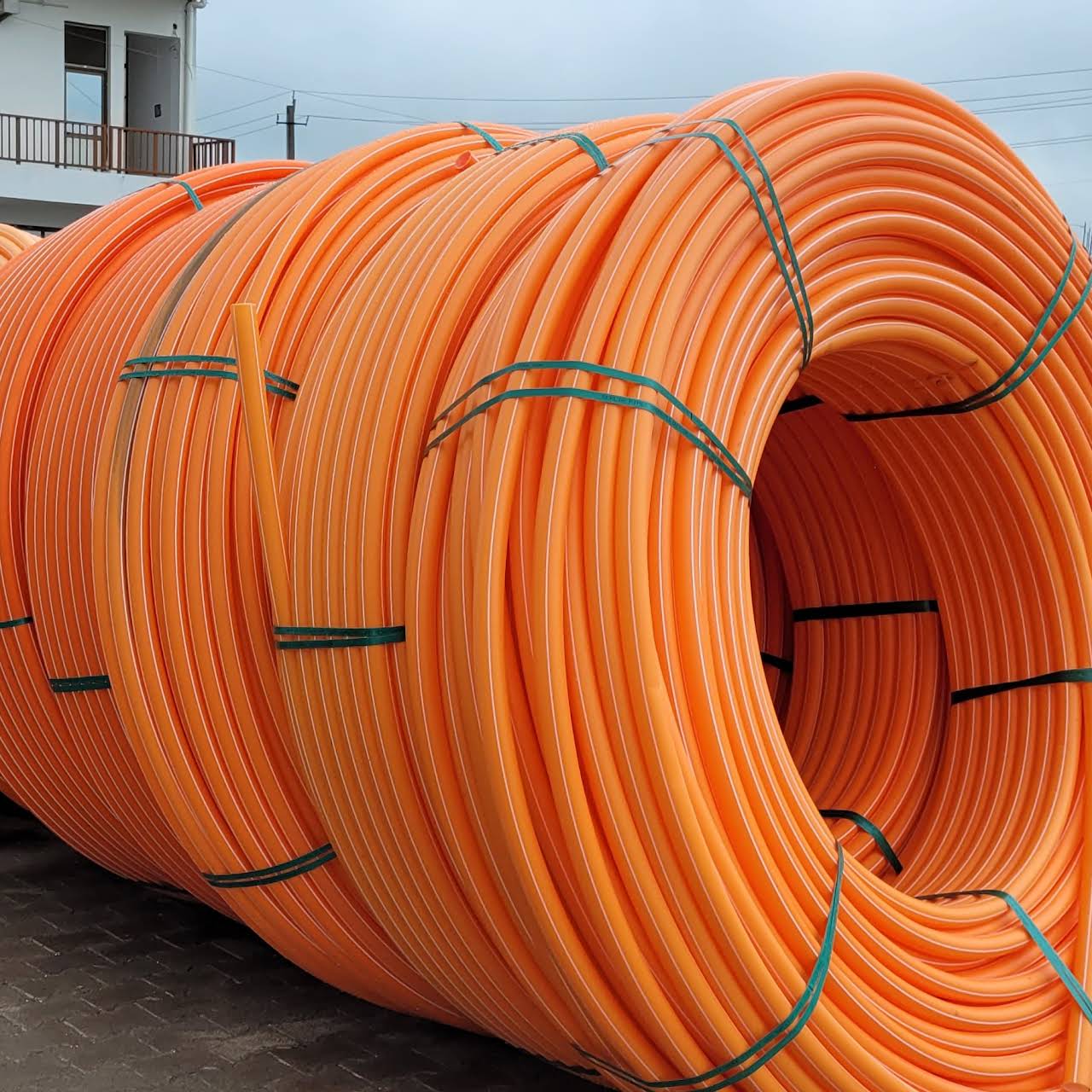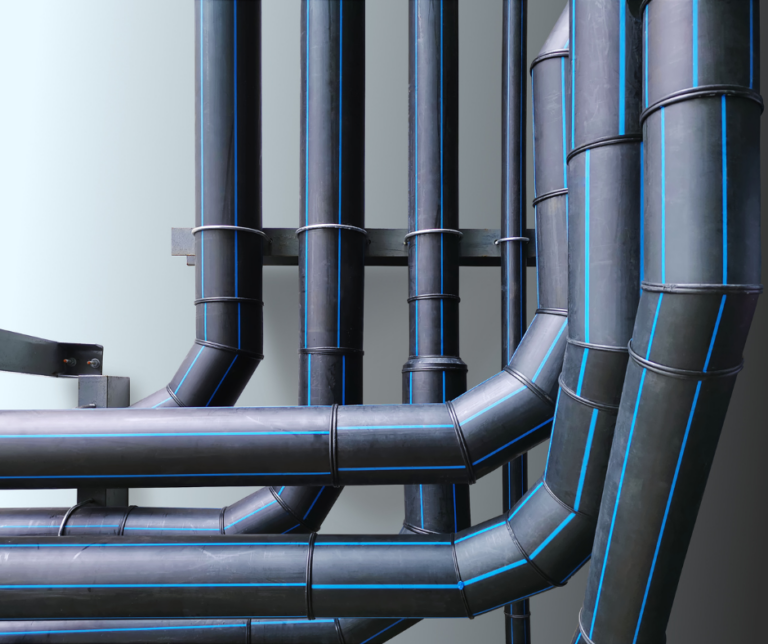American Plastics HDPE Pipe for Oilfield: Built for Harsh Conditions
Wiki Article
Check Out the Manufacturing Refine Behind High-Quality HDPE Pipe and Its Applications
The manufacturing process of top notch HDPE pipelines is intricate and methodical. It starts with the option of raw materials that improve efficiency. Following this, ethylene undertakes polymerization to form material, which is after that formed through extrusion. Quality control is critical, making certain that the final product satisfies strict requirements. Nonetheless, the journey of HDPE pipes doesn't finish with manufacturing. Their applications across different industries expose a broader importance worth examining.Understanding HDPE: Qualities and Advantages

High-density polyethylene (HDPE) is a versatile thermoplastic understood for its toughness and resistance to various ecological aspects. This material displays excellent tensile stamina, making it suitable for requiring applications. Its low-density structure adds to a light-weight product, facilitating convenience of taking care of and setup. HDPE additionally showcases impressive resistance to chemicals, which minimizes destruction when revealed to extreme materials.
The product's reduced dampness absorption better boosts its longevity, making it perfect for use in pipes and storage containers. Additionally, HDPE is immune to ultraviolet (UV) radiation, making sure that products keep their integrity even when revealed to sunlight. In addition, its versatility allows for the production of intricate shapes without compromising toughness. The environmentally friendly nature of HDPE, often derived from recycled materials, includes to its appeal, advertising sustainable methods in production. On the whole, these residential or commercial properties and advantages make HDPE a preferred choice for various commercial and consumer applications.
Basic Material Option for HDPE Manufacturing
The choice of basic materials for HDPE production is necessary to verify the final item satisfies the preferred specifications and quality standards. High-density polyethylene (HDPE) is largely generated from polymerized ethylene, derived from fossil fuels such as gas or crude oil. The quality of these feedstocks considerably influences the mechanical and thermal homes of the last HDPE.Ingredients also play a significant duty in enhancing HDPE's efficiency, consisting of anti-oxidants, UV stabilizers, and colorants, which boost sturdiness and resistance to ecological variables. The option process should consider not only the chemical structure of the raw materials however additionally their handling attributes to guarantee efficient manufacturing.
The sourcing of raw products need to focus on sustainability and compliance with ecological guidelines, as responsible techniques are essential in today's market. Ultimately, cautious raw material choice lays the structure for generating high-quality HDPE pipes appropriate for diverse applications.
The Extrusion Refine: Forming HDPE Pipe
The extrusion process plays an important role in shaping HDPE pipes, starting with meticulous product preparation strategies that assure perfect circulation and uniformity. Similarly crucial is the style of the die, which straight affects the last dimensions and surface high quality of the pipeline. Together, these factors contribute substantially to the performance and quality of HDPE pipeline manufacturing.Product Prep Work Strategies
Effective production of HDPE pipelines starts with careful material prep work methods, particularly the extrusion process. During this stage, high-density polyethylene material is first dried out to eliminate wetness, ensuring excellent flow characteristics. The resin is after that fed into the extruder, where it undergoes heating and melting, transforming into a viscous state. This heating procedure is very carefully controlled to preserve the product's integrity and performance. The molten HDPE is compelled with a die, shaping it right into a constant pipeline form. Appropriate temperature administration throughout extrusion is important, as it directly influences the material's properties and the end product quality. Once formed, the HDPE pipe is cooled down and reduced to defined lengths, all set for succeeding handling and applications.Die Layout Value
Precision in die layout plays a crucial role in the extrusion procedure of HDPE pipes. The die serves as the final shaping tool, straight influencing the pipeline's measurements, wall thickness, and surface area coating. A well-designed die assurances consistent product flow, decreasing defects such as irregularities and vulnerable points. The geometry of the die should be enhanced to suit the details residential or commercial properties of HDPE, including its thickness and thermal actions throughout extrusion. In addition, the cooling price of the material as it travels through the die can noticeably impact the pipe's architectural integrity. Spending in innovative die modern technology is crucial for makers intending to generate premium HDPE pipes that fulfill industry criteria and customer assumptions.Quality Control Steps in HDPE Manufacturing
Although different elements affect the high quality of HDPE pipeline manufacturing, effective high quality control measures are essential to guarantee consistency and integrity in the end product. Secret quality assurance techniques consist of strenuous material examination, verifying that the raw polyethylene meets well established requirements for pureness and thickness. During the extrusion process, parameters such as temperature level, pressure, and cooling time are closely monitored to preserve dimensional precision and architectural honestyIn enhancement, post-production testing is essential; manufacturers frequently conduct hydrostatic tests to assess the pipeline's toughness and resistance to stress. Aesthetic inspections for surface issues better improve quality control. Certification from pertinent criteria companies, like ASTM or ISO, supplies an added layer of trustworthiness. By applying these detailed quality assurance measures, makers can decrease defects, boost efficiency, and ensure that the HDPE pipelines fulfill the particular needs of numerous applications, ultimately causing client satisfaction and trust in the item.
Applications of HDPE Pipeline Throughout Industries
HDPE pipelines are utilized throughout different industries due to their sturdiness and flexibility. In water circulation systems, they ensure effective distribution, while in wastewater administration, they offer dependable remedies for waste transport. Furthermore, agricultural irrigation networks take advantage of HDPE's resistance to corrosion and adaptability, making it a suitable option for modern-day farming techniques.
Water Distribution Equipments
A substantial variety of markets count on high-density polyethylene (HDPE) pipelines for reliable water distribution systems. Known for their durability and resistance to rust, HDPE pipes are extensively made use of in metropolitan water supply networks, agricultural irrigation, and industrial applications. Their lightweight nature facilitates simple handling and installation, lowering labor expenses and time. Furthermore, HDPE pipes can fit different stress degrees, making them ideal for both low and high-pressure systems. Texas hdpe pipe manufacturer. The adaptability of the material allows for smooth integration right into existing framework, decreasing the need for considerable excavation. HDPE's resistance to chemical seeping guarantees that the water delivered continues to be safe and tidy, making it an optimal choice for maintaining the top quality of potable water throughout various industries.Wastewater Administration Solutions
Effective water distribution systems additionally pave the way for ingenious wastewater management options, where high-density polyethylene (HDPE) pipes play a substantial duty. Renowned for their resilience and resistance to rust, HDPE pipes are excellent for carrying wastewater in numerous setups. Their adaptability enables very easy installation in complex atmospheres, reducing the demand for extensive excavation. Additionally, HDPE's smooth interior surface area lowers rubbing, boosting view publisher site flow prices and efficiency. These pipes are also resistant to chemical leaching, making certain that impurities do not jeopardize the surrounding atmosphere. Industries, municipalities, and therapy facilities increasingly depend on HDPE pipelines for their integrity and long life, making them a favored selection for modern wastewater monitoring systems. This adaptability emphasizes the critical value of HDPE pipes throughout various applications.Agricultural Irrigation Networks
Agricultural watering networks benefit considerably from the usage of high-density polyethylene (HDPE) pipelines, which offer efficient and trustworthy water distribution to crops. HDPE pipelines are light-weight, making them very easy to deliver and install, while their versatility enables various setups in diverse terrains. These pipelines show excellent resistance to deterioration, chemicals, and UV radiation, making certain toughness in severe agricultural settings. Furthermore, their smooth indoor surface area reduces friction loss, maximizing water circulation and lowering energy expenses related to pumping. The long life of HDPE pipes, frequently surpassing 50 years, contributes to lower maintenance and substitute expenses. Farmers significantly depend on HDPE pipelines to enhance watering efficiency and promote lasting agricultural methods, ultimately leading to boosted crop yields and resource conservation.
Future Fads in HDPE Pipeline Technology
As the demand for sustainable and effective framework grows, innovations in HDPE pipeline technology are positioned to change various industries. Emerging trends include the assimilation of clever technologies, such as sensing units and IoT capabilities, which promote real-time tracking of pipe conditions, reducing upkeep expenses and avoiding leakages. Additionally, the development of sophisticated manufacturing methods, such as 3D printing, is making it possible for the manufacturing of complicated, customized pipeline styles that accommodate particular task requirements.The focus on recycling and round economic climate practices is driving the innovation of HDPE pipes made from recycled products, improving sustainability. Boosted jointing techniques, such as electro-fusion and mechanical fittings, are also improving installment performance and dependability. Lastly, the growing focus on ecological guidelines is pressing manufacturers to take on greener production processes, ensuring that HDPE pipelines not only fulfill sector requirements yet additionally foster a more sustainable future for facilities development.
Often Asked Inquiries
Exactly How Does HDPE Contrast to Various Other Plastic Products?
HDPE outshines many other plastic products concerning longevity, chemical resistance, and flexibility. Its low density and high tensile stamina make it excellent for different applications, often surpassing choices in both performance and durability.What Are the Ecological Impacts of HDPE Manufacturing?
The ecological impacts of HDPE manufacturing include greenhouse gas emissions, power intake, and prospective air pollution from making procedures. In addition, inappropriate disposal can result in soil and water contamination, elevating concerns about lasting eco-friendly results.Can HDPE Piping Be Recycled?
Yes, HDPE pipes can be recycled. Many centers approve utilized HDPE for handling, transforming it into new items. This reusing contributes to sustainability efforts, decreasing plastic waste while conserving resources and power in the manufacturing cycle.What Is the Life Expectancy of HDPE Water Lines?

How Do Temperature Variants Affect HDPE Pipeline Efficiency?
Temperature variants significantly brass pipe fittings impact HDPE pipeline efficiency, impacting flexibility and strength. High temperature levels can lead to softening, while low temperature levels might trigger brittleness, inevitably affecting the pipeline's durability and suitability click to investigate for various applications in diverse environments.Report this wiki page